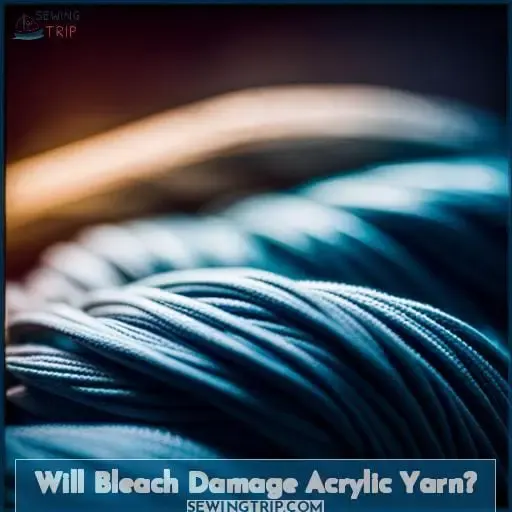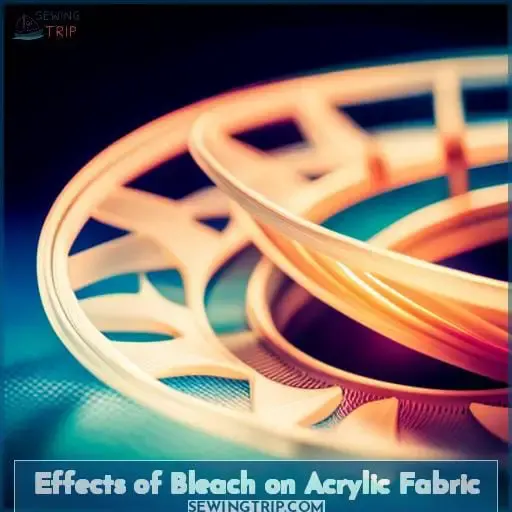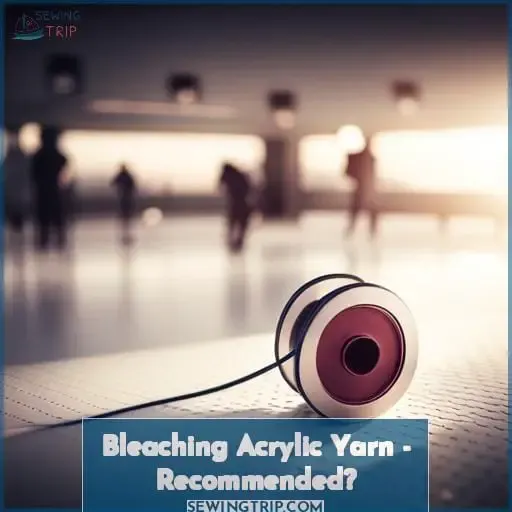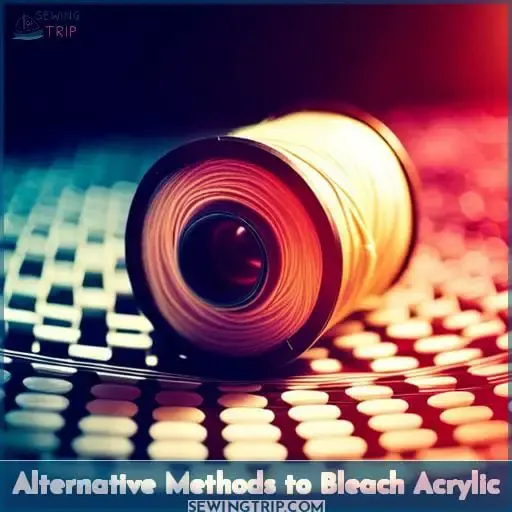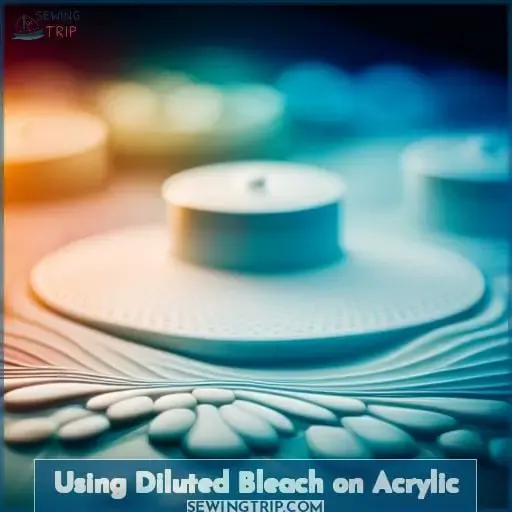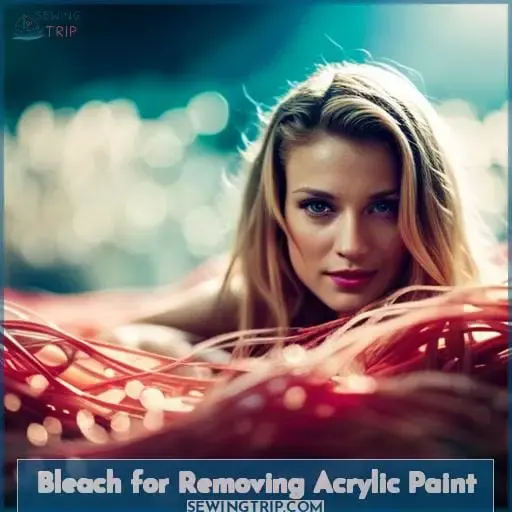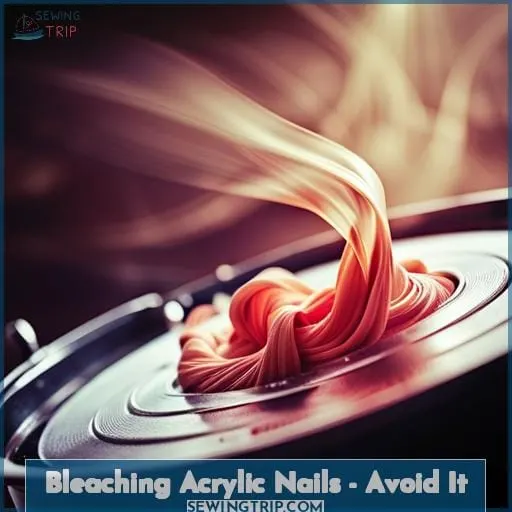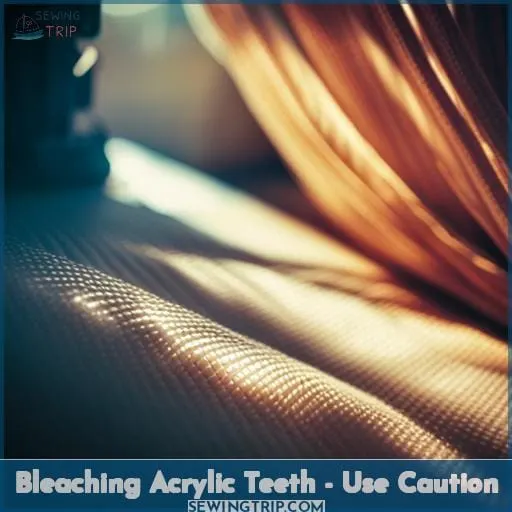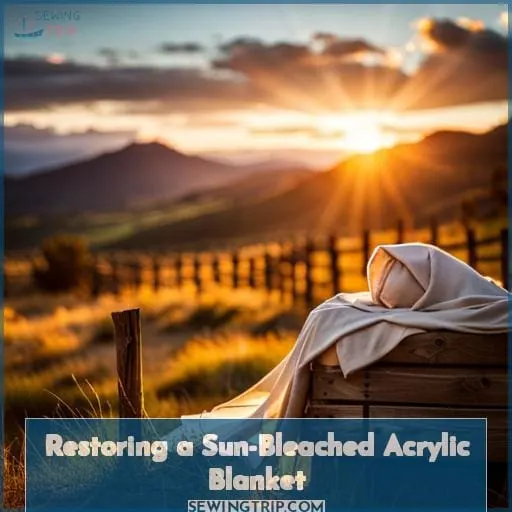This site is supported by our readers. We may earn a commission, at no cost to you, if you purchase through links.
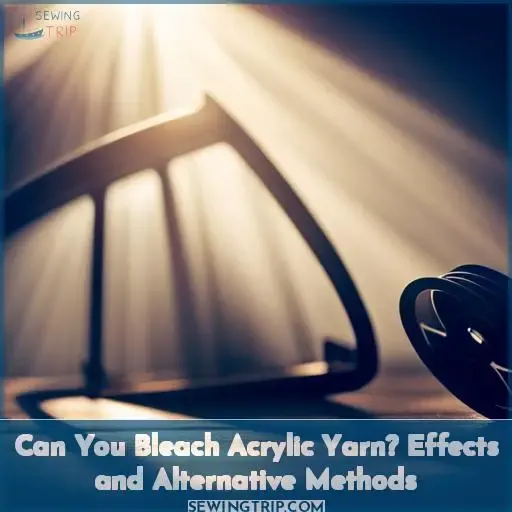 You’re right, bleaching acrylic yarn can be risky. Instead, try sun-fading for a natural, low-risk approach:
You’re right, bleaching acrylic yarn can be risky. Instead, try sun-fading for a natural, low-risk approach:
Simply set your blanket outside in direct sunlight, checking periodically until it lightens to your preferred shade. Be patient – this process may take a few weeks. But sun-fading is gentler than using chemicals.
And just imagine how satisfying it will feel to give your blanket new life through some sun, air and your own creativity! With a bit of time and patience, you can gently fade your blanket to just the right color.
Table Of Contents
- Key Takeaways
- Will Bleach Damage Acrylic Yarn?
- Effects of Bleach on Acrylic Fabric
- Bleaching Acrylic Yarn – Recommended?
- Alternative Methods to Bleach Acrylic
- Using Diluted Bleach on Acrylic
- Bleach for Removing Acrylic Paint
- Cleaning Acrylic Tubs With Bleach
- Bleaching Acrylic Nails – Avoid It
- Bleaching Acrylic Teeth – Use Caution
- Restoring a Sun-Bleached Acrylic Blanket
- Conclusion
Key Takeaways
- Bleach can severely damage acrylic yarn by dissolving its fibers.
- Bleach can lead to brittleness, shrinkage, color loss, and weakened structure in acrylic yarn.
- It is not recommended to bleach acrylic yarn due to potential damage to synthetic fibers that may occur.
- Instead of using bleach, color removers made specifically for synthetics should be used.
Will Bleach Damage Acrylic Yarn?
You’d be playing with fire trying to whiten that blanket. Bleach can ravage acrylic yarn, dissolving its very fibers. Like a vicious predator stalking helpless prey, bleach corrodes acrylic’s polymer structure.
My friend, embrace the sun-kissed patina of your blanket. Its new ombre adds character and makes it uniquely yours.
Transform the blemish into beauty by accentuating the lightened area with embroidery or applique.
Most importantly, keep acrylic yarn creations out of prolonged sunlight and never use bleach.
Let the blanket inspire reconnection with its history and your loved one’s cherished memories.
Effects of Bleach on Acrylic Fabric
Your cherished childhood blanket, now sun-scarred beyond recognition. Bleach can further damage the acrylic fibers, causing:
- Brittleness and breakage
- Shrinkage or distorted shape
- Loss of color vibrancy
- Weakened blanket structure
While bleach may remove some sun-fading, it poses too many risks for acrylic fabrics. It’s better to revive the blanket through careful washing, strategic placement of decorative patches, or creative re-purposing of the material.
Guard against future sun damage by storing projects in opaque bags and boxes. With care and creativity, you can give new life to your cherished keepsake without bleach.
Bleaching Acrylic Yarn – Recommended?
Lesson learned painfully: Sun’s rays rapidly ruin your meticulously crafted keepsakes. When acrylic yarn is exposed to the sun’s UV rays, the colorants can break down, resulting in fading or bleaching.
Though tempting, bleaching acrylic yarn isn’t recommended. The bleach can damage or weaken the synthetic fibers.
Your best bet is to prevent sun damage by storing projects indoors or using UV-protective bags. If sun-bleaching occurs, consider camouflaging the area with appliques or patches using color-matched yarn.
Or opt for a sun-faded ombre look by intentionally exposing the entire project to create a graduated light-to-dark effect.
With some creativity, you can give new life to your treasured sun-kissed creation.
Alternative Methods to Bleach Acrylic
When it comes to brightening or removing color from acrylic yarn or fabric, skip the bleach. Instead, consider using a color remover formulated for synthetics or gradually sun fading the material by intermittently exposing it to direct sunlight over time.
Color Removers
Considering color removers may not work well on acrylic, you’ll want to explore other options for restoring the sun-bleached blanket’s original color. Look into sunlight exposure and acrylic yarn safety. Bleach alternatives for stain removal may be better bets.
However, evaluate color remover effectiveness first, since they’re gentler than bleach. With trial and error, you can likely salvage your blanket without compromising the yarn.
Sun Fading
- Sun fading can be unpredictable and uneven. Sections may fade at different rates, leaving blotchy areas.
- Overexposure can damage fibers and weaken the blanket’s structure. Prolonged UV exposure degrades acrylic over time.
- Wetting the blanket speeds up fading but also increases sun damage if left damp too long.
- Weather conditions affect results. Cloudy/rainy days provide less intense sun. Very hot days may over-dry the fibers.
- Outdoor drying takes time and can’t be rushed. Leaving unattended risks theft or other damage.
- Sun fading gradually washes out colors rather than removing them. Strong dyes may remain visible.
- Once begun, the process is hard to reverse. Some loss of vibrancy is permanent.
- Indoor sunlight has less intensity for fading. Outdoor sun is much stronger.
- Test sections first to gauge the time needed for full fading. Progress can’t be accurately predicted.
In summary, sun fading takes patience and monitoring to mitigate risks. It works best for items not needing uniform results.
Using Diluted Bleach on Acrylic
Mixing a splash of bleach into your cleaning solution is like throwing gasoline on a fire – you’re playing with matches that could ignite and scorch your acrylic fibers in the blink of an eye. With diluted bleach and sunlight exposure, tread lightly with extreme caution. This combo intensifies the bleaching process and the potential for irreversible damage.
Saturate a cotton swab with the diluted bleach and spot test a small hidden area first. Acrylic paint may lift, but textural irregularities could result. Monitor closely and immediately rinse if fibers appear compromised.
Limit exposure. Consider color removers first for more acrylic-friendly fading. When bleach is unavoidable, proceed with care, opting for the lowest concentration that produces results.
Bleach for Removing Acrylic Paint
- Use a gentle cloth and warm, soapy water right away. Rub softly and avoid harsh scrubbing.
- Try nail polish remover with acetone. Test on a small area first.
- Isopropyl alcohol may work. Dampen and dab repeatedly.
- For dried paint, soak in warm water to loosen. Then gently rub with a soft cloth.
Be very careful using any chemicals on acrylic yarn or fabric. Harsh products can damage the fibers. With some patience and care, you’ll likely be able to remove fresh acrylic paint without too much trouble.
Cleaning Acrylic Tubs With Bleach
You need to check the warranty and restrictions before using abrasive tools on your acrylic tub while cleaning it with warm, soapy water.
When caring for your acrylic tub, avoid bleach and harsh chemicals that could damage the surface. Instead, make a solution of warm water and mild dish soap to clean soap scum and dirt. Use a soft sponge or microfiber cloth, rubbing gently in circles. Rinse thoroughly.
For stubborn stains, create a paste of baking soda and water. Let sit before scrubbing gently.
With proper care, your acrylic tub can look shiny and new for years. After cleaning, dry completely, keeping it out of direct sunlight which can cause discoloration over time.
Protect the finish by checking warranty guidelines before using any abrasive tools or materials.
Bleaching Acrylic Nails – Avoid It
You may be tempted to bleach your acrylic nails at home, but this carries significant risks. Bleach contains harsh chemicals that can damage the acrylic material, weaken the bonds between the acrylic and your natural nails, and irritate the surrounding skin.
More concerning is the threat to your oral health if bleach gets in your mouth. Dentists use bleach for specific whitening procedures, but untrained at-home bleaching jeopardizes your dental work and enamel.
Play it safe by avoiding DIY acrylic nail bleaching. Instead, protect your manicure from sun exposure when possible and see a professional for removal when it’s time for a fresh set.
Bleaching Acrylic Teeth – Use Caution
Avoid going rogue with whitening your pearly whites, as DIY bleaching can lead to tooth decay if you’re not careful. Acrylic dental gear like braces and caps may seem convenient for cheap cosmetic bleaching, yet such actions risk ruining that thousand-dollar smile.
Seek professional guidance before attempting any whitening methods, as the acrylic used in dental work has particular chemical properties. Dentists use diluted bleach for specialized procedures, but bleaching those pearly whites solo can erode enamel and irritate your gums.
Take care of your choppers by letting licensed experts handle whitening – smile-savers skilled in safely bleaching your teeth without decay.
Your mouth will thank you for not taking risks with drugstore whiteners on acrylic dental work.
Restoring a Sun-Bleached Acrylic Blanket
Let’s focus our discussion on options for restoring your sun-bleached acrylic blanket. You’ll want to find an acrylic-specific dye since Rit isn’t suitable. Consider creating a colorfast patch made from matching yarn.
Evaluate fabric markers for potential color blending risks. Or look into professional textile restoration services for cost-effective solutions.
Dyeing
Consider acrylic-friendly dyes to gently restore color without damaging fibers. Look for dyes designed for synthetic fibers when dyeing acrylic yarn. Start with small skeins to color match before treating the entire blanket. Consider an inconspicuous spot for test strips.
While professional blanket restoration provides experience, simple hand-dyeing reconnects you with the fibers. Embrace sun-kissed hues or recreate the original palette – either way, your renewed vision will warm any heart.
Patching
Patch the discolored area with matching yarn to fix the blanket without harming its texture. Carefully select a yarn in the original colorway. Use a blanket stitch to neatly secure small patches. For large areas, duplicate the basket weave pattern when patching. Gently block the finished patch to blend with undamaged sections.
Store projects indoors and avoid direct sunlight to prevent future sun damage. With thoughtful color-matching and patching, you can restore the cherished blanket.
Markers
You could try coloring in the faded area with fabric markers, but be careful because they may bleed.
- Test markers on a scrap piece first.
- Use short, light strokes.
- Avoid saturation.
- Set colors with heat.
Markers can potentially restore color, but take care not to damage the blanket further.
Professional Services
Wowsers, having a professional service restore that sun-scorched blanket would be the cat’s meow, saving you a peck of trouble trying to DIY it. Expert textile restoration services can truly perform magic, darling, reviving fabrics with specialized techniques.
Let the professionals take a crack at color-matching and re-dyeing your precious acrylic heirloom. With their years of experience, they’ll whip that blanket back into tip-top shape in a jiffy – good as new! Sure, it’ll cost you, but some things are priceless.
Conclusion
As an experienced fiber artist, I want to share one surprising fact: sunlight can actually fade acrylic yarn over time. So how can you revive sun-damaged acrylic pieces? While bleaching is risky, try sun-fading in reverse to even out the color.
And for future projects, be sure to keep acrylic out of prolonged sunlight to avoid potential damage. The key point is that with some creativity and care, you can restore the beauty of cherished acrylic yarn creations.

